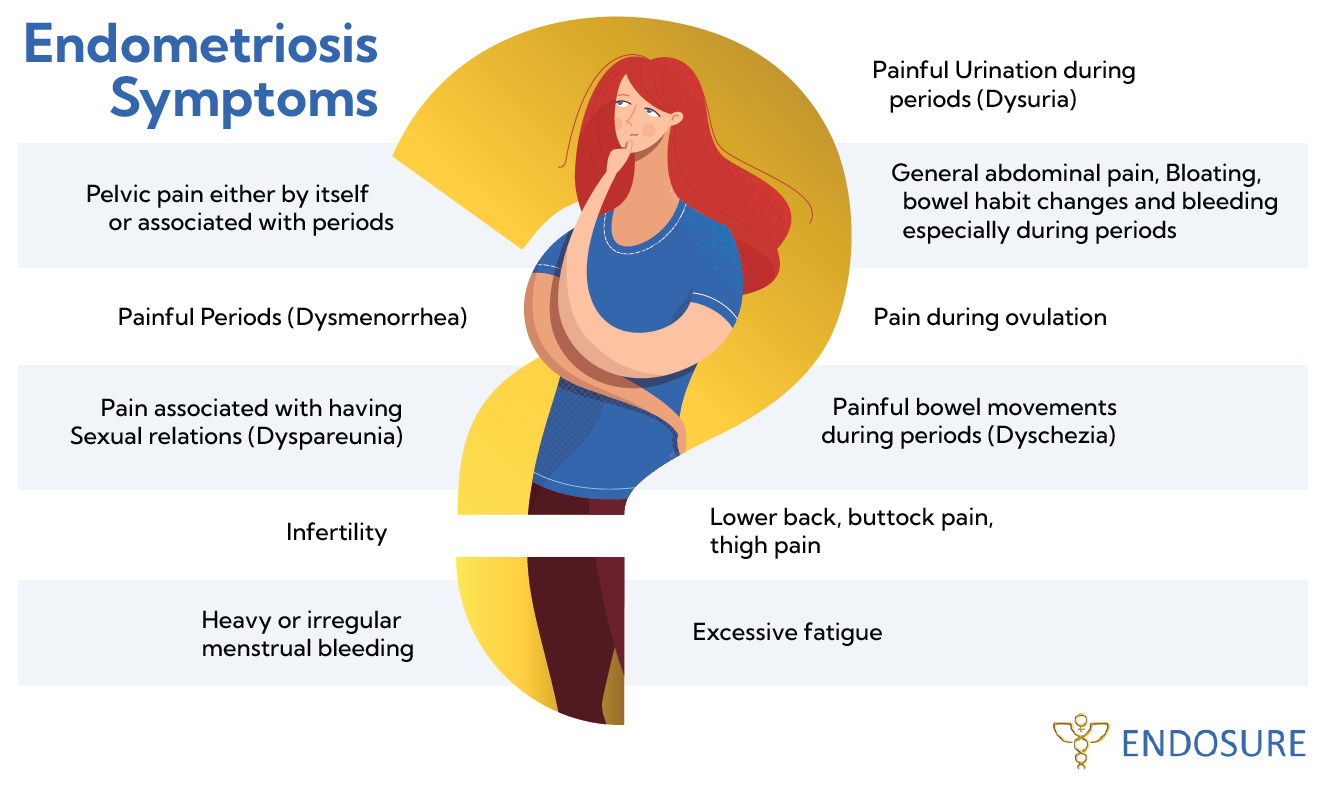Endometriosis is a chronic condition where tissue similar to the lining of the uterus grows outside of the uterus, often causing significant discomfort and complications. Affecting millions of women worldwide, it can profoundly impact quality of life. Recognizing its symptoms is crucial for early diagnosis and management. Below, we explore the common symptoms of endometriosis in detail, shedding light on their characteristics and effects.

1. Pelvic Pain (With or Without Periods)
Pelvic pain is a hallmark of endometriosis, often described as a deep, aching, or cramping sensation in the lower abdomen or pelvis. This pain may occur independently or intensify during menstrual periods. Unlike typical menstrual cramps, endometriosis-related pelvic pain is relentless and can persist throughout the month, varying in intensity. It may feel like a constant dull ache or sharp, stabbing pain, and can radiate to the lower back or thighs. The severity often correlates with the metabolic activity of endometrial tissue growth rather than the stage, extent, or location of the disease.
2. Painful Periods (Dysmenorrhea)
Dysmenorrhea, or intensely painful periods, is one of the most common symptoms of endometriosis. Women may experience severe cramping that begins before menstruation and continues for several days. The pain can be debilitating, interfering with daily activities and sometimes requiring strong pain relief. This is caused by the inflammation and irritation from endometrial tissue outside the uterus, which responds to hormonal changes during the menstrual cycle, leading to localized bleeding and pain.
3. Pain During Sexual Intercourse (Dyspareunia)
Dyspareunia refers to pain during or after sexual activity, often described as a deep, internal discomfort in the pelvic region, it may also present as a superficial form at the initiation of penetration. . This symptom arises when endometrial implants or scar tissue (adhesions) in the pelvic cavity are disturbed during intercourse. The pain may vary depending on the position or depth of penetration and can persist for hours afterward, affecting emotional well-being and intimate relationships.
4. Infertility
Infertility is a significant concern for many women with endometriosis, with up to 30-50% of affected women experiencing difficulty conceiving. Endometriosis can impair fertility by causing adhesions that distort pelvic anatomy, blocking fallopian tubes, or affecting egg quality and implantation. Inflammation from endometrial tissue may also create a hostile environment for sperm or embryos. Women with endometriosis may require fertility treatments, such as in vitro fertilization (IVF), to conceive.
5. Heavy or Irregular Menstrual Bleeding
Women with endometriosis may experience abnormally heavy menstrual flow (menorrhagia) or irregular bleeding, such as spotting between periods. Heavy bleeding can lead to prolonged periods, passing large clots, or the need to change sanitary products frequently. This symptom is thought to result from hormonal imbalances or the presence of endometrial tissue affecting the uterine lining’s normal shedding process. This may occur with a different form of endometriosis known as adenomyosis, which is when the endometriosis tissue invades the wall of the uterus.
6. Painful Urination During Periods (Dysuria)
Dysuria, or painful urination during menstruation, occurs when endometrial tissue grows near the bladder or urethra. This can cause a burning or stinging sensation during urination, sometimes accompanied by an urgent need to urinate or frequent trips to the bathroom. The pain is typically cyclical, worsening during periods due to inflammation and hormonal changes affecting the pelvic tissues.
7. Painful Bowel Movements During Periods (Dyschezia)
Dyschezia refers to painful or difficult bowel movements, particularly during menstruation. When endometrial implants affect the rectum, intestines, or surrounding pelvic structures, women may experience cramping, straining, or sharp pain during defecation. This symptom can be accompanied by constipation, diarrhea, or a feeling of incomplete bowel emptying, especially during periods.
8. Lower Back, Buttock, or Thigh Pain
Pain radiating to the lower back, buttocks, or thighs is common in endometriosis, often due to referred pain from pelvic inflammation or nerve irritation, it may also be associated with endometriosis lesion in the sacrum or spinal nerves. This pain may feel like a deep ache or sharp twinges and can worsen during periods or physical activity. It may also be mistaken for sciatica or musculoskeletal issues, complicating diagnosis.
9. Pain During Ovulation
Some women with endometriosis experience sharp or cramping pain during ovulation, known as mittelschmerz. This mid-cycle pain occurs when endometrial tissue stimulated by estrogen secretion, irritates the ovaries or surrounding structures during the enlargement of the egg follicles or release of an egg. The discomfort may last a few hours to a couple of days and can be accompanied by bloating or nausea.
10. General Abdominal Pain, Bloating, and Bowel Habit Changes
Generalized abdominal pain, bloating (often called “endo belly”), and changes in bowel habits—such as diarrhea, constipation, or alternating patterns—are frequent in endometriosis. These symptoms often worsen during menstruation due to inflammation and hormonal fluctuations. Bloating may cause visible abdominal distension, discomfort, or a feeling of fullness, impacting daily comfort and body image.
11. Excessive Fatigue
Chronic fatigue is a less recognized but debilitating symptom of endometriosis. Women often report feeling exhausted, even after adequate rest, due to the physical toll of chronic pain, inflammation, and hormonal imbalances. Fatigue can also stem from disrupted sleep caused by pain or heavy bleeding, contributing to a cycle of reduced energy and emotional strain.
12. Rectal Bleeding
Rectal bleeding during menstruation, though rare, can occur when endometrial tissue invades the rectal or intestinal wall. This may manifest as blood in the stool or bright red bleeding during periods, often accompanied by painful bowel movements. This symptom requires prompt medical evaluation to rule out other gastrointestinal conditions.
Conclusion
Endometriosis presents a complex array of symptoms that can vary widely in intensity and impact. It has been variably characterized as an inflammatory, auto immune or motility disorder. From debilitating pelvic pain and painful periods to infertility and gastrointestinal issues, these symptoms can significantly affect physical, emotional, and social well-being.
Up until recently, it has been difficult to diagnose endometriosis due to the absence of a Tier 1 diagnostic test. These First-Tier diagnostic tests are now available and known as the ENDOSURE TEST. First Tier diagnostic tests are important because they provide the earliest indication of the presence of disease with a highest accuracy and are usually the simplest to perform. Without Tier-1 testing, diagnosis is difficult and relies on less accurate anatomic localization testing like transvaginal ultrasound, MRI and invasive laparoscopic surgery. This has resulted in treatment to be empirical rather than targeted, only prolonging the time to actual diagnosis while the disease progresses.
If you or someone you know experiences these symptoms, consult a
healthcare provider for a thorough evaluation and insist on the Tier-1 ENDOSURE TEST. Early diagnosis and tailored treatment—ranging from pain management to surgical intervention—can help manage symptoms and improve quality of life. Awareness and education are key to empowering women to seek the care they need.


